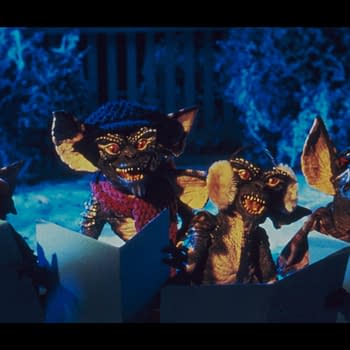Posted in: Movies, Recent Updates | Tagged: Cassy Sark, collectibles, Don Figueroa, Galvatron, hasbro, idw, leonard nimoy, third party toys, transformers
A Robot In Disguise By Any Other Name: Third-Party Transformers Toys
By Spencer Ellsworth
Here I am, exactly where I shouldn't be.
In the virtual sense, that is. I'm on eBay, cruising Transformers for deals. Yes, I am a grown-ass man with a huge Transformers collection.
Tonight, I seek the perfect Galvatron. You remember Galvatron: in the hair-metal powered 1986 animated film, Megatron got upgraded to a purple body and a golden cannon, memorably voiced by Leonard Nimoy. His 1986 toy was only slightly more articulated than a block of wood. Six-year-old me wore it out anyway.

In the depths of eBay I find my perfect Galvy, and he is glorious.
Snarling! Purple. Cannoned! Straight out of 1986. Seven inches of pure plastic power. You can almost hear the Flying Vs, shredding away.
He is also called Maniaking, manufactured by Unique Toys, not to be confused with Galvatron, manufactured by Hasbro. In fact, he is advertised as "Not Galvatron."

Why would anyone want a Transformer, as good as it might be, for 100$, when the Hasbro equivalent would retail for 25$? In the words of one fan, on the TFArchive board, "The producers don't have to worry about mass appeal or brick and mortar retailers, child safety regulations or gimmicks, vehicle design licenses, etc. and are working at price points that allow for better finishes than retail toys, use of die cast and so forth."
My four-year-old son can tell you that Hasbro toys are easy to break. Joints wear out, the cheap plastic splits and cracks, and I've stayed up late into the night shoving heated-up straight pins into weak joints and gluing pressure points to try and preserve my little guy's collection. For a collector, most Hasbro products are too cheaply painted, Day-Glo bright with little surface detail.
My third party TFs, in contrast feel like they were made out of a football helmet. When my son has managed to raid my collection, the master thief (seriously, how does a four-year-old get up to a shelf eight feet off the ground?) they've resisted his punishment. They're posable, detailed and dignified, with classy paint jobs. They give the toy shelf some real class.
Those are just a few reasons why they're 100$ a pop. And here is where I balk. Boy oh boy, is Maniaking Not Galvatron beautiful.
The cheapest one starts bidding at 70$.
But… he is so beautiful.
So are his brothers in unlicense. Ever wanted steampunk Transformers? The Reformatted brand Knight Morpher figures turn into, respectively, a WW1-era submarine for Shockwave, WW1-era planes for Starscream and pals, and Optimus Prime becomes a lovely steam train.


They look so good, and meet specific needs, because the companies source their designs, right from the fans who have been customizing their toys. Cassy Sark started out computer-modding his own Transformers for 3D printing while he was working as a product designer. Sark would post his designs "on forums and Facebook, where they were then seen by current clients." Sark now works retooling and creating designs for numerous third-party companies—his contributions include the Mech Ideas Demolition Crue (Not Wreckers, again), Reformatted Feral Rex (Not Predacons), and a host of others. Sark couldn't tell me much about the process of contracting with the companies, but he did make it clear that, unlike the in-house design and supply of Hasbro, the third-parties operate as small businesses tapping into a network.
It makes sense to mine fan designs. Fans have been sharing their kit bashes of Transformers since the beginning of the Internet. Generation Y fans grew up drawing Transformer designs in 80s, and now the IDW comics artists find that they might inadvertently be giving gold to Hasbro.
Don Figueroa, a fan-favorite comics artist, drew working alternate modes for the full range of TFs, including a Megatron-as-stealth-bomber model. They were originally comics-only designs, with no toy equivalents. Big fan faves, those were, and they were soon adopted by Hasbro for the Titanium and Generations lines… with no compensation for Figueroa.
There is a lesson here for budding artists: don't go to work on licensed products and hand a design over to Hasbro! Your custom is your cool idea, and you can sell it to a third party.
If you think you hear Hasbro's lawyers grind their teeth, you're not alone. Only the shady legalities of Asian multinational manufacturing, and a network of independent distributors, make third-parties possible.
Hasbro might be cautious after the recent Chapterhouse Games lawsuit, in which a number of Warhammer 40k third-party toys survived a copyright lawsuit. The ruling specifically states that copyright and trade law cannot be used to block "add-on" products. The Transformers third parties feature a host of add-ons, including new guns, new head sculpts, transforming trailers for trucks… but they are mostly original figures these days. Take one look at Orion and Hegemon and you'll be scratching your head as to how their parent company ToyWorld has stayed out of court.

The major legal backlash never came. The final answer seems to be in effort: were you Hasbro, would you pay a legal team to chase down manufacturers in the back of Malaysian warehouses, given that they are only cutting into a small portion of your market?
Hasbro's response seems to be no, not worth it. For adult collectors, Hasbro's Masterpiece line is high-quality and cheaper. Maniaking and his ilk, who fit into the smaller toy lines, threaten just a few adults with disposable income and bad priorities. Third-parties now host panels at the conventions where they were once banned, previewing their upcoming designs to, well, guys like me (and their four-year-old sons, plotting the next heist).
Oddly enough, the price of third-party toys, at their high quality and limited release, better reflects the true costs of little plastic toys than the mainstream ones. Hasbro has been cited for contracting with abusive sweatshops in China, where one 25$ Transformer earns the assembly-line worker 17 cents.
Hasbro accesses a massive worldwide supply chain of partners, buying plastic made from oil byproducts refined in the USA, shaping the plastic in China, and sending it back around the world. Few industries are as costly, in the long term, as toys. They ship all over the world, they require petroleum in huge quantities at every stage, they produce pollutants and hazardous materials, and take advantage of the poor in the developing world.
Third-parties could be the option for a more discerning consumer to buy a more humane Transformer, if they are manufactured in Thailand, where some unionization is possible, unlike the Communist party-rigged unions in China and Vietnam. One is already supporting a small startup instead of a multinational corporation—that's if one can get over the fact that this startup exists by ripping off the multinational corporation.
As one fan put it, on Transfans.co.uk, "They obviously still have a mark-up, but we don't know much about production runs or the scale of overseas markets." Most Transfans who learn about Hasbro's supply chain have become a bit disgusted. If it were clear that a decent Transformer, in human and environmental costs, required at least 100$, perhaps fans would find even more reasons to flee to third-parties.
To do so, though, would require transparency, which is the last thing most third-party toy makers want. No companies responded to my requests for interviews—in Sark's words, "They keep their cards pretty close to their chest."
Hasbro's newly adopted tolerance may also reflect a longer-term investment: making official TF designs available on Shapeways, the community for 3D printing enthusiasts. There are few areas where 3D printing has as much potential as it does for toy collectors. More craft-minded fans are already ordering TF designs on the site, and doing custom paint jobs once the figures are printed. Sark himself started out there. The more ubiquitous the printers become, the more easily grown-ass men with bad priorities will buy, or pirate, blueprints to print the perfect Galvatron. Hasbro is no doubt more interested in the upcoming battle over DRMs for 3D printed toy designs than they are in a few independent manufacturers, and there is little room for third-parties in that world, other than as independent designers flying under the radar. Certainly Shapeways addresses the issue of Hasbro's carbon and human costs in the future.
Of course, there's no telling how that will change Hasbro's relationship to the fans—whether they'll begin to source (read: pay for) fans' designs as the third-parties do from Sark, or whether there'll be more stories like Don Figueroa's.
Finally, you don't have to be a Hasbro business analyst to observe a bubble, close to bursting. It's hard for a small company to survive on 100$ toys that folks may or may not order, when character demand is the trickiest part of the market. Right now, there are about seven Dinobot lines spread among the third parties. Keith's Fantasy Club recently got scooped by Hasbro themselves when their Citizen Stack, a high-quality Ultra Magnus, had his Hasbro official Masterpiece-model counterpart announced—bigger, matching the rest of the Masterpiece line, same price. If you decide to release a certain third-party Transformer, you'll have to hit a unique mix to make a profit: not too many competitors, widespread appeal, and little chance that Hasbro will create a cheaper version anytime soon.
And so I have Maniaking Not Galvatron. I won the eBay auction at 80$, plus shipping. He came in a sturdy box, packed in foam. His transformation is way too complicated but great fun. He's heavy and his plastic so hard that I cut myself on his horns.
He's got a wonderfully evil scowl. You can practically hear Leonard Nimoy growling, "Ultra Magnus is mine." And when I see him on my shelf, I can't resist a little air guitar.
I know I just blew a Benjamin on a Transformer. But he reminds me of why I love this stupid hobby—because I was an imaginative seven-year-old, and as a grown-ass man, with a real job, bills to pay, little mouths to feed, and not much money to spare for my hobbies, this company on the Internet knows exactly how to recapture that feeling.
For now, that feeling costs 100$ a pop.
Big thanks to Cassy Sark, and the forums at TFArchive and Transfans.
Spencer Ellsworth has written about comics for Bleeding Cool since 2013, and all over the Internet since 2007. He has also published short fiction in many venues, including the Magazine of Fantasy & Science Fiction, maintains a blog and bibliography at spencerellsworth.com and twitters @spencimus.
















